Related Research Articles

Electricity is the set of physical phenomena associated with the presence and motion of matter that has a property of electric charge. Electricity is related to magnetism, both being part of the phenomenon of electromagnetism, as described by Maxwell's equations. Various common phenomena are related to electricity, including lightning, static electricity, electric heating, electric discharges and many others.
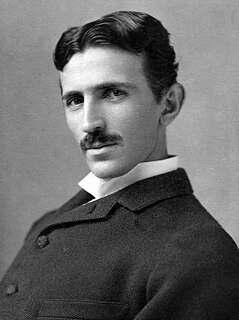
Nikola Tesla was a Serbian-American inventor, electrical engineer, mechanical engineer, and futurist best known for his contributions to the design of the modern alternating current (AC) electricity supply system.
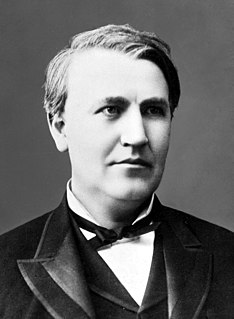
The war of the currents was a series of events surrounding the introduction of competing electric power transmission systems in the late 1880s and early 1890s. It grew out of two lighting systems developed in the late 1870s and early 1880s; arc lamp street lighting running on high-voltage alternating current (AC), and large-scale low-voltage direct current (DC) indoor incandescent lighting being marketed by Thomas Edison's company. In 1886, the Edison system was faced with new competition: an alternating current system developed by George Westinghouse's company that used transformers to step down from a high voltage so AC could be used for indoor lighting. Using high voltage allowed an AC system to transmit power over longer distances from more efficient large central generating stations. As the use of AC spread rapidly, the Edison Electric Light Company claimed in early 1888 that high voltages used in an alternating current system were hazardous, and that the design was inferior to, and infringed on the patents behind, their direct current system.

Cabinets of curiosities were collections of notable objects. The term cabinet originally described a room rather than a piece of furniture. Modern terminology would categorize the objects included as belonging to natural history, geology, ethnography, archaeology, religious or historical relics, works of art, and antiquities. The classic cabinet of curiosities emerged in the sixteenth century, although more rudimentary collections had existed earlier. In addition to the most famous and best documented cabinets of rulers and aristocrats, members of the merchant class and early practitioners of science in Europe formed collections that were precursors to museums.
Fluid theories of electricity are outdated theories that postulated one or more electrical fluids which were thought to be responsible for many electrical phenomena in the history of electromagnetism. The "two-fluid" theory of electricity, created by Charles François de Cisternay du Fay, postulated that electricity was the interaction between two electrical 'fluids.' An alternate simpler theory was proposed by Benjamin Franklin, called the unitary, or one-fluid, theory of electricity. This theory claimed that electricity was really one fluid, which could be present in excess, or absent from a body, thus explaining its electrical charge. Franklin's theory explained how charges could be dispelled and how they could be passed through a chain of people. The fluid theories of electricity eventually became updated to include the effects of magnetism, and electrons.

Francis Hauksbee the Elder FRS (1660–1713), also known as Francis Hawksbee, was an 18th-century English scientist best known for his work on electricity and electrostatic repulsion.

The history of electromagnetic theory begins with ancient measures to understand atmospheric electricity, in particular lightning. People then had little understanding of electricity, and were unable to explain the phenomena. Scientific understanding into the nature of electricity grew throughout the eighteenth and nineteenth centuries through the work of researchers such as Coulomb, Ampère, Faraday and Maxwell.
Ebenezer Kinnersley was an English scientist, inventor and lecturer, specializing in the investigation of electricity.

John Peter Gassiot FRS [also Gassiott] was an English businessman and amateur scientist. He was particularly associated with public demonstrations of electrical phenomena and the development of the Royal Society.

James Graham (1745–1794) was a Scottish proponent of electrical cures, showman, and pioneer in sex therapy. A self-styled doctor, he was best known for his electro-magnetic musical Grand State Celestial Bed. Dismissed as a quack by medical experts, Graham apparently believed in the efficacy of his unusual treatments.
Throughout the 19th century, Philadelphia's Franklin Institute was often the organizer of American-held international exhibitions that showcased the achievements of industrial civilization. For example, it played a key role in organizing and hosting the International Electrical Exhibition of 1884 in Philadelphia. This, the first great electrical exposition in the United States, was held from September 2 to October 11, 1884.
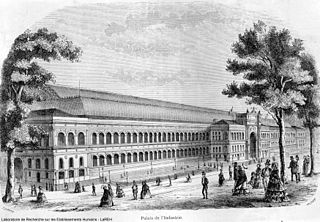
The first International Exposition of Electricity in Paris ran from August 15, 1881 through to November 15, 1881 at the Palais de l'Industrie on the Champs-Élysées. It served to display the advances in electrical technology since the small electrical display at the 1878 Universal Exposition. Exhibitors came from the United Kingdom, United States, Germany, Italy and the Netherlands, as well as from France. As part of the exhibition, the first International Congress of Electricians presented numerous scientific and technical papers, including definitions of the standard practical units volt, ohm and ampere.
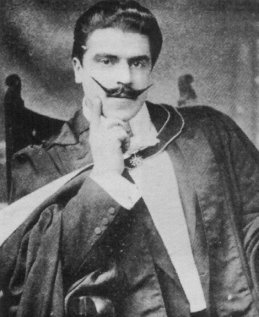
Walford Bodie, whose real name was Samuel Murphy Bodie, was a Scottish showman, hypnotist, ventriloquist and stage magician, famous for his "mock" electrocutions involving a replica of "The Electric Chair". He also performed an act of "Bloodless Surgery", claiming he could use electricity, hypnosis and manipulation to cure "all kinds of ailments and disabilities". His performances were enormously popular in the early 20th century, and inspired both Harry Houdini and Charlie Chaplin.
Animal magnetism, also known as mesmerism, was the name given by German doctor Franz Mesmer in the 18th century to what he believed to be an invisible natural force (Lebensmagnetismus) possessed by all living things, including humans, animals, and vegetables. He believed that the force could have physical effects, including healing, and he tried persistently but without success to achieve scientific recognition of his ideas.
"The Electric Boy" is the tenth episode of the American documentary television series Cosmos: A Spacetime Odyssey. It premiered on May 11, 2014 on Fox, and aired on May 12, 2014 on National Geographic Channel. The episode was directed by Bill Pope, and written by Ann Druyan and Steven Soter. The episode explores the Earth's magnetic field and the contributions of Michael Faraday, which paved the way for high technology and light-speed communication.
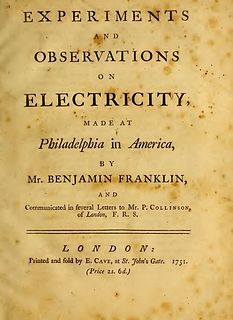
Experiments and Observations on Electricity is a mid-eighteenth century book consisting of letters from Benjamin Franklin. These letters concerned Franklin's discoveries about the behavior of electricity based on experimentation and scientific studies. The book came in pamphlet form for the first three English editions. The last two editions were in a book volume with hard covers and a book spine. There were eleven European editions of the book: five English editions, three French editions, and a German, Italian and Latin edition. The publication was well received worldwide. It was considered America's most important scientific book of the eighteenth century.

Franklin's electrostatic machine is a high-voltage static electricity-generating device used by Benjamin Franklin in the mid-18th century for research into electrical phenomena. Its key components are a glass globe which turned on an axis via a crank, a cloth pad in contact with the spinning globe, a set of metal needles to conduct away the charge developed on the globe by its friction with the pad, and a Leyden jar – a high-voltage capacitor – to accumulate the charge. Franklin's experiments with the machine eventually led to new theories about electricity and inventing the lightning rod.
Archibald Spencer was a businessman, scientist, doctor, clergyman, and lecturer. He did seminars on science and for a while made a living at this. His lecture demonstrations were on medicine, light, and electricity. He is noted for introducing the phenomenon of electricity to Benjamin Franklin. As a businessman, he made investments in and helped form Anne Arundel County, Maryland.

The electric fire engine is a fire engine with a water pump, used to distribute water to put out a fire, operated by an electric motor. Electric fire engines were first proposed in the 19th century to replace the steam pumpers used for firefighting. The electric motor was claimed to be simpler, cleaner, and faster in operation, would save money, and require less maintenance than the steam fire engine. Contemporary battery-operated models also exist.
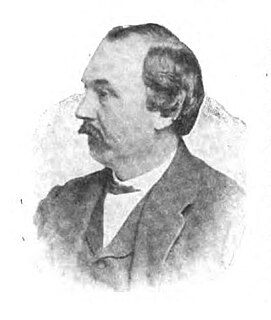
Thomas Hall was an American mechanic, physicist, inventor and manufacturer. He worked with the inventor Daniel Davis for many years co-inventing electric and telegraph equipment. He later ran his own business, manufacturing and selling electric components, electromagnetic devices and telegraph apparatus. He received many gold and silver awards for his innovations. One of his electricity experiments was a toy model-size electric locomotive that got its power directly off the tracks it was running on, which was a new concept and technology at the time. He was mostly associated with Boston and the area.
References
- 1 2 Delbourgo, James, 1972- (2006). A most amazing scene of wonders : electricity and enlightenment in early America. Harvard University Press. ISBN 0-674-02299-8. OCLC 64208386.
{{cite book}}: CS1 maint: multiple names: authors list (link) - ↑ Kinnersley, Ebenezer (1752). Notice is hereby given to the curious : that at the Court-House, in the Council-Chamber, is now to be exhibited, and continued from day to day, for a week or two ; a course of experiments, on the newly discovered electrical fire ... James Franklin. OCLC 25461550.
- ↑ Schaffer, Simon (March 1983). "Natural Philosophy and Public Spectacle in the Eighteenth Century". History of Science. 21 (1): 1–43. doi:10.1177/007327538302100101. ISSN 0073-2753. PMID 11611179. S2CID 38140290.
- ↑ Lemay, J. A. Leo (Joseph A. Leo), 1935-2008. (1964). Ebenezer Kinnersley, Franklin's friend. University of Pennsylvania Press. ISBN 978-1-5128-1757-7. OCLC 600290864.
{{cite book}}: CS1 maint: multiple names: authors list (link) - ↑ Daston, Lorraine (2001). Wonders and the order of nature 1150-1750. Zone Books. ISBN 0-942299-91-4. OCLC 248541422.
- 1 2 3 4 Gooday, Graeme (2011), "Electricity and the Sociable Circulation of Fear and Fearlessness", Geographies of Nineteenth-Century Science, University of Chicago Press, pp. 203–228, doi:10.7208/chicago/9780226487298.003.0009, ISBN 978-0-226-48726-7
- ↑ "The international exhibition–view of the sout-eastern transept". doi:10.17658/issn.2058-5462/issue-05/arobinson/figure6.
{{cite journal}}: Cite journal requires|journal=(help)